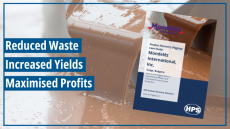New cost cutting, sustainable technology for dairy processors, claims Tetra Pak
Tetra Pak said that its Tetra Lactenso Aseptic includes new energy and product saving technologies, IntelliCIP and Aseptic Energy Hibernation, as well as upgraded versions of existing processing units, the Tetra Therm Aseptic Flex and the Tetra Alsafe buffer tank.
Dairy processors are looking to offset the increasing high cost pressure of acquiring ingredients for their operations so sustainable and cost effective initiatives are of growing interest to the sector.
Energy savings Tetra Pak said that the IntelliCIP is a new cleaning programme that can reduce chemical use by up to 20 per cent and adjusts the cleaning sequence to the exact time and inputs required: " This improves overall environmental sustainability while also reducing operating costs."
The company claims that savings can also be achieved through the use of the new Aseptic Energy Hibernation unit, which it said lowers steam, water and electricity consumption by up to 75 per cent when the UHT system is in water stand-by mode.
Product loss The enhanced Aseptic Flex offers processors an unprecedented 40 hours of running time between cleanings and a 40 per cent reduction in product loss, according to the processing equipment and packaging supplier.
"Tetra Therm Aseptic Flex and VTIS are able to greatly reduce product losses because of their double balance tank system.
Because the mixing phases of product and water are kept to a minimum, there is less wastage," claims the company.
Bespoke design Tetra Pak said they aim to provide a bespoke design for each dairy customer and will look at the totality of their production, rather than just the individual elements.
"We work with each of [our] specific customers to understand the performance targets they wish to achieve, such as liters per hour of output, product quality or sustainability benchmarks.
Then [we create] a custom designed solution that is guaranteed to meet the agreed targets," added the company.
Carbon footprint
The dairy industry is increasingly concerned about the environmental impact of producing, processing and producing milk.
Last month, the UK's Department for Environment, Food and Rural Affairs (DEFRA), in conjunction with industry group Dairy UK and other stakeholders, set out a roadmap aimed at reducing the industry's carbon footprint.
These targets include a timeline on cutting carbon dioxide (CO2) emissions and water use related to milk production, while also agreeing not to send any factory produced waste to landfill sites by 2020.
The global dairy industry looks set to adopt similar environmental commitments.
Jimmy Begg, president of the International Dairy Federation (IDF), helped to draw up the UK guidelines.
He said that he had been inundated with requests from other countries for further information on the initiative.
"The roadmap is relatively unique and could help serve to ensure improved worldwide supply chain cooperation on dealing with reducing environmental impacts throughout dairy production," said Begg.














